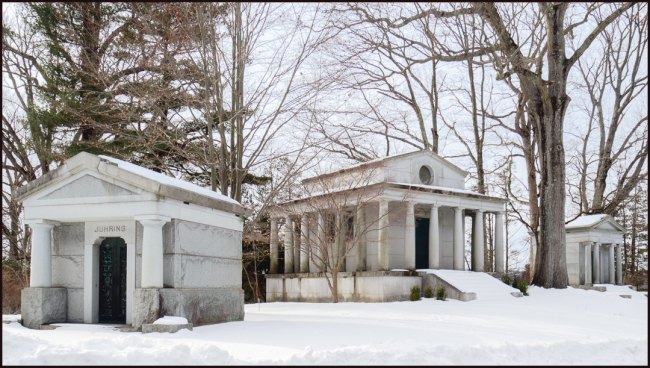The largest one is the mausoleum in the Middle, the final resting place of William Boyce Thompson:
Business Magnate. He operated silver and copper mines in Montana and Arizona. He moved to New York City, New York and became director of the Federal Reserve bank of New York (1914 to 1919) and was twice a delegate to the Republican National Convetion (1916, 1920). In 1919, he founded the Boyce Thompson Institute for Plant Research in Yonkers, New York which has since become a research institute of Cornell University. He also founded the Boyce Thompson Arboretum in Superior, Arizona. His life has been memorialized in a biography entitled “The Magnate” by Hermann Hagedorn. (Find a Grave)
On the left the mausoleum of John C. Juring and his wife Frances Bryant Fisher Juhring.
J.C. Juhring, merchant, was born in New York City and is the son of John C. and Lena (Stuke) Juhring. His father was a successful real estate operator during the period from 1850 to 1875, and at the time of his death resided in Lincoln Place (Wilson Street), Brooklyn. John C. the younger received his preliminary education in the public schools, and after a preparatory course entered Mount Washington Collegiate Institute from which he was graduated in 1869. He entered the employ of Francis H. Leggett & Company, importing and manufacturing grocers, in 1873, and as the result of a close attention to his duties, reliability and rapidly acquiring the knowledge necessary to develop and push business, he was rapidly advanced in positions of trust. He was given an interest in the firm’s profits, and in 1892 he was admitted to partnership. In1892, when the firm was changed to a corporation, he was chosen as its Vice President and Secretary. He was one of the charter members of the Merchant’s Association of New York, and at its first meeting in 1897, he was elected its first Vice-President and proved to be one of its most active workers. Imbued with an unusual degree of civic pride, he laid plans to secure members, and with a short period after its organization he succeeded in adding to the membership roll one hundred and fifty representative firms.
Mr. Juhring is recognized as a public-spirited citizen, and one who always has in mind the welfare and best interests of the city of his birth.
…
Mr. Juhring’s eminent executive and business qualifications have led to his selection for many positions of trust. He is a director of the Coal and Iron National Bank of New York City, a Trustee of the Citizens Savings Bank, besides being connected in a similar capacity with many other commercial institutions. In politics he is a Republican, but of independent views, and he has given his unqualified support to all the movements looking to an improved condition in the administration of the local government. He is a member of the Merchant’s Club of New York as well as of several important out-of-town social organizations. He was married on October 19, 1901, at the Majestic Hotel, in New York City, to Miss Frances Bryant Fisher, an interesting feature of the wedding being the presence of Miss Helen M. Gould as one of the bridesmaids.
It has been well said of Mr. Juhring by one who knows him intimately: “He possesses a pleasing personality and a wonderful capacity for details. He combines perseverance with persistency; great tenacity of purpose to accomplish results. His motto is ‘Keep on keeping on’. He is self-contained, courteous in manner, somewhat reserved, yet straightforward and a strict disciplinarian, but well liked for his fair dealings’ (First Citizens of the Republic: An Historical Work Giving Portraits and Sketches of the Most Eminent Citizens of the United States, 1906. Page 207-208. He is included in this volume along with such luminaries as Thomas Edison, Mark Twain, and William Howard Taft – All of them middle aged to elderly white men of course.) .
The third mausoleum is inscribed “Dula Wightman”, but so far I have been unable to find any information about it.
Taken with an Olympus OM-D EM-10 and Panasonic Lumix G Vario 14-42 f3.5-4.6 II

